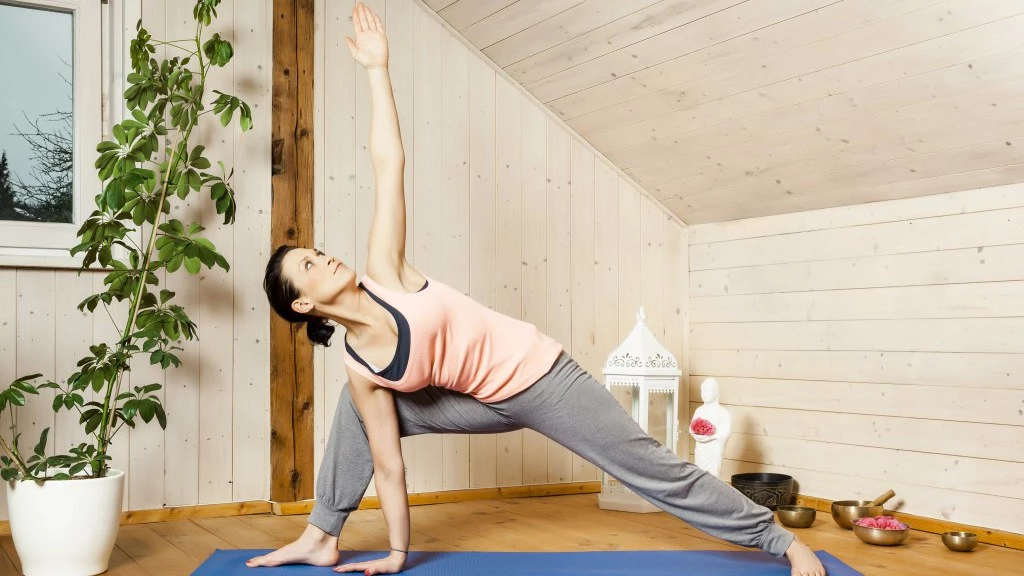Which Is More Effective—Yoga or Stretching?

For some, yoga just looks like sequenced stretching. New preliminary research suggests that yoga may have greater effects on increasing hip range of motion than static stretching alone, and that both are linked to greater shoulder mobility.
Scientists at Laurentian University in Ontario, Canada, were interested in determining whether adults (age 18-65 years: average 34 years) participating in hatha yoga classes for 4 weeks would differ in their hip and shoulder ROM from matched comparison groups doing either an equivalent amount of time stretching, or no stretching at all.
Range of motion (ROM) refers to the movement of any specific joint. It depends on the bony structure of the joint itself, as well as the health of the connective tissues and the length of the muscles “spanning the particular joint.” So inflexible muscles would also contribute to a reduced range of motion.
Forty-four adults volunteered for the study (33 female). Participants in the yoga group (11) attended one-hour classes, two evenings per week for 4 weeks. Those in the static stretching group (12) also attended two, one-hour classes per week for 4 weeks. Control group participants (21) were instructed not to stretch for the same period of time. ROM was assessed using a gonimeter, which measures angles similar to a protractor.
Two days prior to the beginning of yoga and stretching classes, each participant underwent gonimeter measurement. The researchers measured shoulder flexion, extension, abduction, adduction, horizontal abduction and horizontal adduction on the left and right sides of each individual. They then measured hip flexion, extension, adduction and abduction on both sides.
After 4 weeks of classes, both the static stretching and yoga groups demonstrated significant overall improvement in range of motion (ROM) compared to the control group. Yoga participants demonstrated considerably greater increases in overall hip and shoulder ROM than those in the stretching group.
In addition, the yoga participants experienced significantly greater increases in hip range of motion compared to both the stretching and control groups. In contrast, increases in shoulder ROM were similar for both groups, suggesting that yoga and stretching were equally effective in increasing shoulder joint mobility.
When breaking ROM into individual action, two shoulder motions were found to be significantly different between the yoga and stretching groups. Yoga participants had significant increases in shoulder abduction, while static stretchers had greater horizontal adduction. This may be a result of different types of motion being emphasized between the two groups. For the hips, yoga participants demonstrated significant increases in adduction compared to the other two groups.
The authors hypothesized that yoga’s superior effects on increased ROM were due to a combination of the use of asana, pranayama and meditation throughout class. Unfortunately, they did nothing to test this assumption. This could have been accomplished by randomly assigning participants to two separate yoga groups – one that performed only the postures themselves with no breath queues, and one that included the three components combined. As it stands, it is possible that the yoga postures were solely responsible for the increased ROM.
Another limitation of the study was that while attendance was measured, there was no mention of the level of participation for each of these types of classes or the dropout rates between groups. Consequently, we have no way of knowing whether these results may be attributed to the number of sessions attended rather than the type of activity, and the extent to which yoga and stretching were utilized by this sample. Further, as noted by the authors, “there are joint differences … between male and female participants, which could create variation in results.”
This study provides very preliminary evidence that yoga may be more beneficial to increasing hip and shoulder ROM than static stretching alone. More, carefully controlled studies are needed to determine whether postures, breath, or some combination are responsible for these types of effects.
 B Grace Bullock, PhD, E-RYT 500, is the Founding Director of the International Science & Education Alliance, a firm that provides strategic planning, research consultation and assessment design to support the empirically rigorous evaluation and sustainable implementation of programs in education, leadership, health and human services. Grace is an intervention scientist, psychologist, yoga educator and author who has worked extensively in integrated behavioral health settings. Her research, clinical practice, teaching and writing emphasize the incorporation of empirically supported psychotherapy with yoga therapy and mindfulness practices to relieve the symptoms of stress, trauma, anxiety, depression and other psychological illnesses, and to promote healthy relationships. She is Faculty at the Integrated Health Yoga Therapy therapist training program, and Professor of Yoga & Neuroscience at the Taksha University School of Integrative Medicine. Grace is the former Editor in Chief of the International Journal of Yoga Therapy and recipient of a Francisco J. Varela Research Award from the Mind & Life Institute. For more information contact Grace at bgracebullock@me.com or https://www.gracebullock.com/
B Grace Bullock, PhD, E-RYT 500, is the Founding Director of the International Science & Education Alliance, a firm that provides strategic planning, research consultation and assessment design to support the empirically rigorous evaluation and sustainable implementation of programs in education, leadership, health and human services. Grace is an intervention scientist, psychologist, yoga educator and author who has worked extensively in integrated behavioral health settings. Her research, clinical practice, teaching and writing emphasize the incorporation of empirically supported psychotherapy with yoga therapy and mindfulness practices to relieve the symptoms of stress, trauma, anxiety, depression and other psychological illnesses, and to promote healthy relationships. She is Faculty at the Integrated Health Yoga Therapy therapist training program, and Professor of Yoga & Neuroscience at the Taksha University School of Integrative Medicine. Grace is the former Editor in Chief of the International Journal of Yoga Therapy and recipient of a Francisco J. Varela Research Award from the Mind & Life Institute. For more information contact Grace at bgracebullock@me.com or https://www.gracebullock.com/


